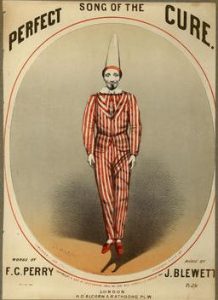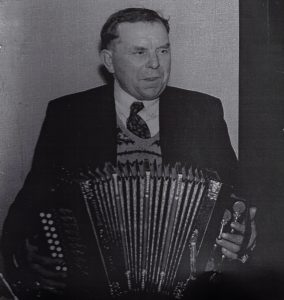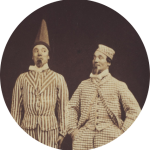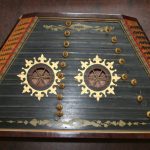 The Perfect Cure is one of several country dance tunes collected in Norfolk which were played for the traditional ‘Long Dance’, and it is often thought of as a quintessentially Norfolk tune. But it turns out that this tune already had a bit of history before that, as suggested by this music cover (left).
The Perfect Cure is one of several country dance tunes collected in Norfolk which were played for the traditional ‘Long Dance’, and it is often thought of as a quintessentially Norfolk tune. But it turns out that this tune already had a bit of history before that, as suggested by this music cover (left).
A little bit of musical archaeology reveals not only other regions that see the tune as being distinctively theirs, but also a glimpse of the way melodies moved between different performing contexts before tunes were pigeon-holed into different genres.
 The Norfolk connection comes from the fact that it was published by the English Folk Dance and Song Society: firstly in ‘The Coronation Country Dance Book’ in 1937, a year or so after it had been noted down from melodeon player Herbert Mallett (right) of Aldborough by folklorist Joan Roe, and subsequently, and probably with a longer lasting influence, in ‘The Fiddler’s Tune Book’ Volume 2 in 1954. In July 1950, Herbert Mallett visited the BBC studios in Norwich and recorded several items including The Perfect Cure.
The Norfolk connection comes from the fact that it was published by the English Folk Dance and Song Society: firstly in ‘The Coronation Country Dance Book’ in 1937, a year or so after it had been noted down from melodeon player Herbert Mallett (right) of Aldborough by folklorist Joan Roe, and subsequently, and probably with a longer lasting influence, in ‘The Fiddler’s Tune Book’ Volume 2 in 1954. In July 1950, Herbert Mallett visited the BBC studios in Norwich and recorded several items including The Perfect Cure.
Dulcimer player Billy Cooper from Hingham also played it, with a slightly different B music, which is given below, however it is Mallett’s version which has become the standard English version of the tune in modern times.

It’s also known – usually as She Hadn’t The Thing She Thought She Had – within the musical tradition of Sliabh Luachra from the Cork/Kerry borders in south west Ireland. Some years ago, Con O’Drisceoil from County Cork was performing at a concert in Suffolk and introduced what he considered to be one of the more unusual items in his local repertoire – a 12/8 jig (known as a slide) – which turned out to be The Perfect Cure. I don’t know who was the more surprised, the audience or Con!
A set of words was noted down from the Oxfordshire fiddler Sam Bennett in 1950:
‘The cure, the cure, the perfect cure, you are a perfect cure,
And all at once the maid she cried, You are a perfect cure!
Some got trampled underfoot, some crushed beneath the wheel,
Lord how the parson he did curse and how the pigs did squeal!’
The phrase ‘perfect cure’ was a slang phrase, current from the mid nineteenth century, for an eccentric and amusing person. The original song dates from that period, and consisted of ten verses written in 1861 by F. C. Perry. The song was a roaring success in the Music Halls, made popular by James Hurst Stead, who, after the final verse, went straight into an early version of the punk pogo dance, where he is said to have jumped up and down 400 times during the song, and sometimes performed it in four different venues in the course of one night!
The actual melody, composed by John Blewett, predates this set of words, as it was originally written for a song called The Monkey and the Nuts. The original tune was written as a schottische although it is now commonly played as a jig.
 There’s a lot more about James Stead on the Studied Monuments blog about the St Pancras and Islington cemetery by Bob Davenport, and for more about the tune itself, visit the excellent Traditional Tune Archive.
There’s a lot more about James Stead on the Studied Monuments blog about the St Pancras and Islington cemetery by Bob Davenport, and for more about the tune itself, visit the excellent Traditional Tune Archive.
 If you’d like to know more about Billy Cooper and East Anglian dulcimers, visit my other website East Anglian Dulcimers
If you’d like to know more about Billy Cooper and East Anglian dulcimers, visit my other website East Anglian Dulcimers
The Vaughan Williams Memorial Library holds the original acetate recordings of Herbert Mallett, and this tune and others can be heard on the Musical Traditions website, in The Life and Times of a Norfolk Melodeon Player by Chris Holderness.
Please note: Anyone wishing to cite this original research should credit it to Katie Howson and cite this website as the source.
© Katie Howson 2021
Oh brilliant! Thanks for sharing your research Katie.